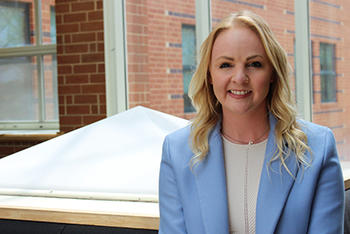In This Story

We tend to believe great innovations speak for themselves. Once they’ve connected with the marketplace, successful innovations acquire an aura of inevitability. It’s easy to forget that they were once only an idea on paper, competing with others for buy-in and resources.
In this earliest stage of innovation, creative proposals are judged according to their perceived novelty and usefulness. Sharaya Jones, assistant professor of marketing at Mason, has a simple yet counterintuitive rule for would-be innovators hawking their ideas: More is more.
Her recent paper in Marketing Science, co-authored by Laura J. Kornish of University of Colorado Boulder, pits verbose and detailed idea descriptions against terse ones. Over several studies, participants were shown random selections from a pool of descriptions—including short, very short, long-winded and highly specific versions of the same basic idea (all of which came from an actual crowdsourcing platform). They then scored each proposal for creativity, market uniqueness, and intent to purchase the hypothetical product. The longer and more specific they were relative to the others viewed by the participant, the higher their creativity score.
Subsequent studies revealed how this maximalist bias works. When participants were surveyed on their experience of reading the descriptions, a chain of associations surfaced between how easy it was to keep track of a description’s central concepts (which the researchers termed “fluency”), perceived complexity and the creativity score. Longer text that ventured into the weeds was harder for the reader to follow, which made it appear more complicated and thus more creative.
“When you have all these different pieces and you’re trying to fit them together, that’s basically the definition of complexity. And there’s a body of research linking complexity and novelty,” said Jones.
Remember, though, that novelty is only one of the two chief creativity criteria—the other being usefulness. When developing products and services for sale to consumers, it’s crucial to keep usefulness in mind, lest you end up with a cool innovation that has no clear practical purpose. The researchers used participants’ purchase intent as a rough indicator of perceived usefulness, as the two qualities are closely related. The correlation between length/granularity and purchase intent was slight to non-existent. Elaborate, highly specific descriptions may have been deemed more creative, but they did not induce readers to open their wallets.
“The more fluent an idea is, i.e., the easier it is to interpret, the more purchase intent increases,” explained Jones. “So that’s why there’s this balance, where novelty and usefulness are kind of at odds with each other.”
Ideally, there would be an equilibrium of novelty and usefulness criteria. But prior research finds that usefulness is often undervalued. Or, as the paper states, “Novelty is a much bigger driver of perceived creativity than usefulness is.” In Jones’s research, extreme length differences between the descriptions magnified this effect.
Therefore, one of Jones’s main takeaways is that in early-stage innovation contests, length requirements for entries should be kept within a fairly narrow range—long enough for evaluators to get the picture but not so long that innovators can start piling on the distracting detail. Indeed, in one study the length/creativity correlation disappeared when the researchers grouped the descriptions by length.
Absent a reasonable maximum length, innovators would obviously want to write more rather than less, throwing in specifics where possible. Jones suggests that the same recommendation may apply to everything from job descriptions (especially if you’re trying to attract millennials or Gen Z candidates looking for a creative workplace) to certain types of product marketing. (i.e., brand extensions where the usefulness of the item is already well-established).
The research also suggests that innovations that are mainly about usefulness—the proverbial better mousetrap—may be very marketable but still have a tough time competing with very novel concepts.” Innate pro-novelty bias can be compounded by dazzling descriptions of bright shiny objects. A good way to cut through the noise may be to augment text with visuals or even physical prototypes to render the proposal’s unique value more tangible.
“Putting a little bit more emphasis on usefulness is definitely something that organizations should be doing,” Jones said. “Figuring out other ways to convey usefulness, outside of the written description, could be very helpful, especially for marketers."
